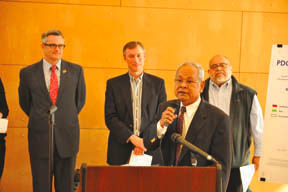 |
||||||||
| MEMO BLOG | Memo Calendar | Memo Pad | Business Memos | Loaves & Fishes | Letters | Home | ||
 |
 |
 |
 |
LEE PERLMAN
THE MID-COUNTY MEMO
 |
| In October Sokhom Tauch, Immigrant and Refugee Community Organization Executive Director, spoke at the meeting at IRCO announcing east Portland areas selected for the Neighborhood Prosperity Initiative, part of the development plan for the Neighborhood Economic Development Strategy, which is a part of City Council's 2009 Economic Development Strategy. The NPI uses public and private funding for a variety of services - some administered through IRCO - attempting to position businesses in NPI areas for economic success. Areas include Parkrose, Cully and parts of outer southeast Portland. Behind him are Portland Mayor Sam Adams, Multnomah County Chair Jeff Cogen and Rey Espana, Director of Community Development at the Native American Youth & Family Center. Mid-county Memo photo/Tim Curran |
Under the Neighborhood Prosperity Initiative, part of the Neighborhood Economic Development Strategy, the City will borrow against future revenues to provide each district with $10,000 in startup funds, and $25,000 to $40,000 in the first year of operation, rising to $100,000 in the seventh and final year. As with conventional urban renewal districts, increased taxes generated by rising property values, over and above what is currently collected, will be placed in special Tax Increment Fund accounts to pay for projects and improvements in the district. After seven years, all tax revenue will go into the General Fund.
The districts include Northeast Sandy Boulevard between the I-5 Freeway and 122nd Avenue, the Rosewood area between Northeast Holladay and Southeast Stark streets on 160th Avenue, Southeast Division Street between 124th and 148th avenues, and Division between Southeast 82nd Avenue and the I-205 Freeway plus 82nd from Division to Powell Boulevard. According to PDC Business and Social Equity Program Manager John Jackley, the areas were selected because they were not in any existing urban renewal district. They were “lagging in commercial investment,” they have low average household income, they have a concentration of small and locally owned businesses, and they have “business or community organizing capacity,” meaning they have a perceived active business or neighborhood association.
Last month PDC called a meeting at the Immigrant and Refugee Community Organization attended by over 100 people representing most of the six districts involved. Volunteers pledged to bring all six forward. They now have until year's end to form a non-profit organization to run the program, or to secure an agreement with an existing group to do this, and until Jan. 31 to write an official application and action plan.
MEMO Advertising | MEMO Archives | MEMO Web Neighbors | MEMO Staff | Home
